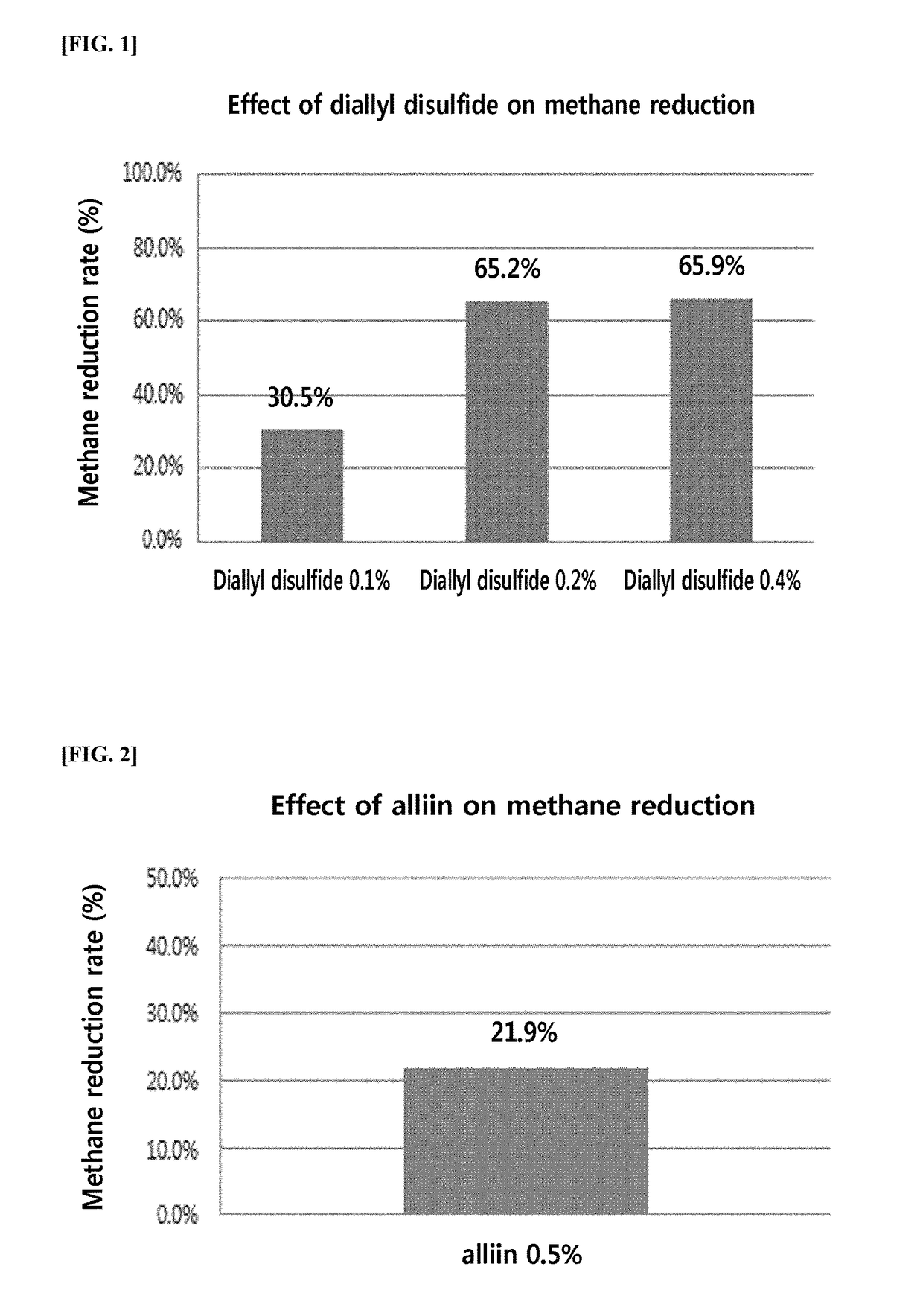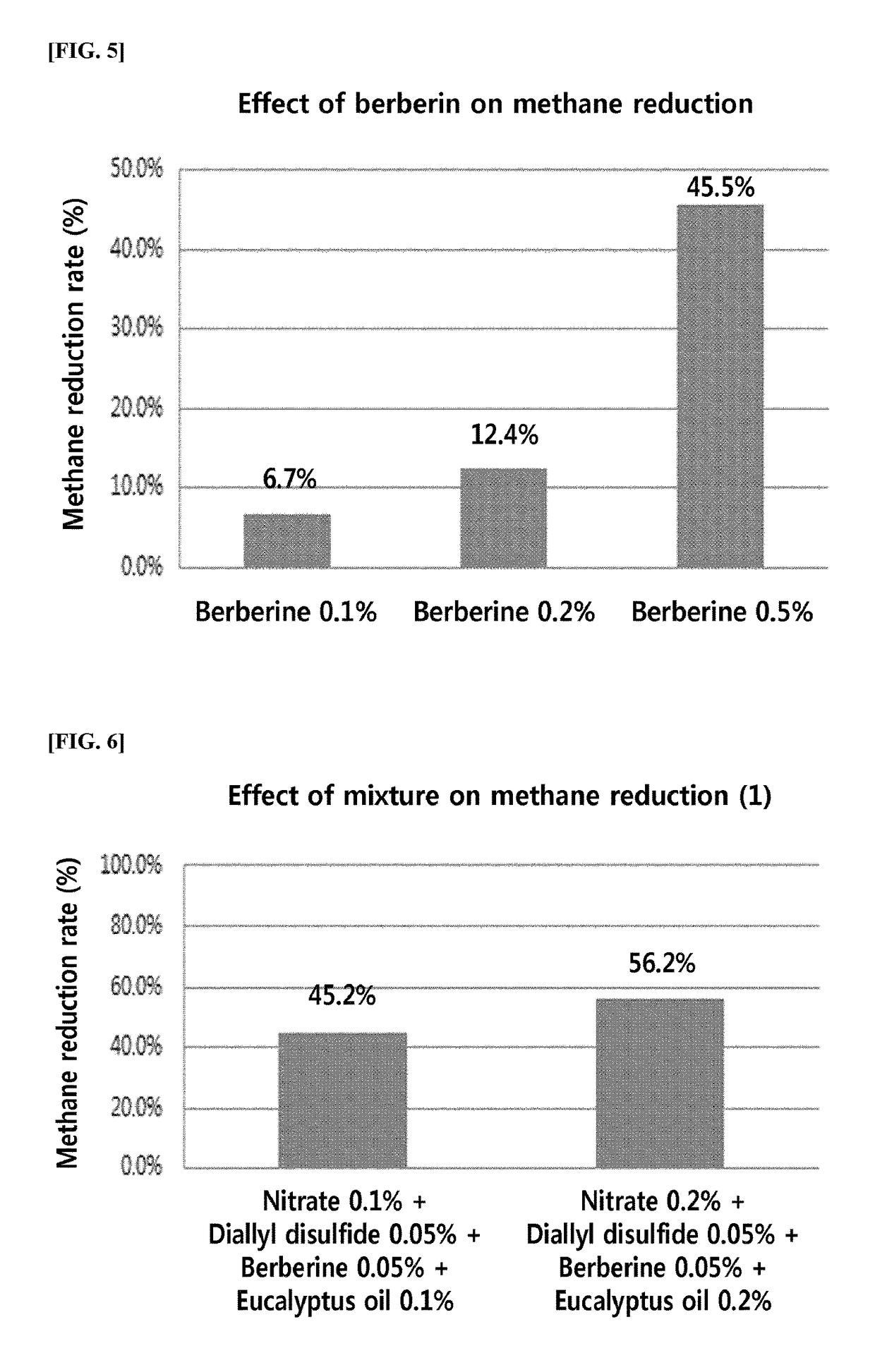Feed additive composition for reducing methane gas produced by ruminant animals
a technology of additive composition and methane gas, which is applied in the field of feed additive composition, can solve the problems and reducing the impact of animal industry on the regional and global environment, and achieving the effect of reducing the production of methan
- Summary
- Abstract
- Description
- Claims
- Application Information
AI Technical Summary
Benefits of technology
Problems solved by technology
Method used
Image
Examples
preparation example
ntinuous Culture System (RSCC)
[0053]1) Buffer Preparation (Per 1 L)
[0054]0.12 mL of a micromineral solution was added to 250 mL of distilled water in an 2 L of Erlenmeyer flask and stirred. Another 250 mL of distilled water was added, and then stirred for 20 minutes. Then, 250 mL of an in vitro buffer solution was added and stirred for 10 minutes. Then, 250 mL of a macromineral solution was added and stirred for 15 minutes. Then, 1.25 mL of a resazurin solution was added to the mixture and stirred. Then, the flask was sealed with aluminum foil and heated while maintaining an anaerobic condition by bubbling CO2 gas in a Hungate anaerobic culture tube. When the solution started boiling, the solution was heated for 10 more minutes and then cooled down. 50 mL of a reduction solution was added to the cooled solution to obtain a buffer. The buffer solution was confirmed to become colorless.
[0055]2) Culture Medium Preparation
[0056]A sampled rumen fluid was first filtered through eight-laye...
example 1
Reduction of Methane Production by a Feed Additive for Reducing Methane
[0059]Below is an experiment on reduction of methane production conducted in accordance with the above operation method using the RSCC system of 3) of Preparation Example. A feed additive for reducing methane was added with the substrate when the substrate was added.
[0060]1) Effect on Reduction of Methane Production by the Addition Amount of Diallyl Disulfide (DADS)
[0061]The RSCC system was operated for five days of adjustment, and then total gas production, methane production, and pH values of the control group were measured for three days. After the measurements of the control group were completed, DADS was added at ratios of 0.1 wt %, 0.2 wt %, and 0.4 wt % per 10 g of a substrate, and then total gas production, methane production, and pH values were measured at the same time for another three days. The methane reduction rate was measured after having an adjustment period with a newly sampled rumen fluid every...
example 2
a Feed Additive for Reducing Methane on Productivity of Milking Cows and Methane Production within the Ruminant Stomach
[0081]Below is an feeding experiment on milking cow conducted to verify a methane reduction effect of the additive mixture composition (power-green premix), described in 6) of Example 1, comprising DADS, nitrate, berberine, and eucalyptus oil; and to examine an effect of the power-green premix on the dairy farming productivity as well. Methane production from milking cows was monitored in real time using a laser methane detector.
[0082]1) Effect of the power-green premix (additive mixture composition comprising alliin, nitrate, berberine, and eucalyptus oil) on the methane production within the ruminant stomach of milking cows
[0083]In order to verify the effect of the power-green premix (DADS:Nitrate:Berberine:Eucalyptus Oil=0.05 wt %:0.1 wt %:0.05 wt %:0.1 wt %) described in 6) of Example 1 on the methane reduction, 40 heads of milking cows were divided into a contr...
PUM
 Login to View More
Login to View More Abstract
Description
Claims
Application Information
 Login to View More
Login to View More - R&D
- Intellectual Property
- Life Sciences
- Materials
- Tech Scout
- Unparalleled Data Quality
- Higher Quality Content
- 60% Fewer Hallucinations
Browse by: Latest US Patents, China's latest patents, Technical Efficacy Thesaurus, Application Domain, Technology Topic, Popular Technical Reports.
© 2025 PatSnap. All rights reserved.Legal|Privacy policy|Modern Slavery Act Transparency Statement|Sitemap|About US| Contact US: help@patsnap.com



